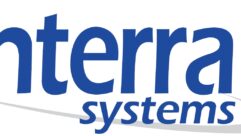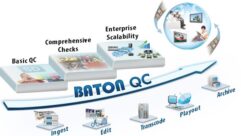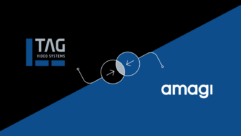Technology Showcase: Rear-Projection Systems
Dec 1, 2003 12:00 PM,
By Bennett Liles
Although front-screen projection is often the way to go for more theatrical applications with little activity by onstage participants, rear-screen systems have found acceptance in the necessarily brighter environments such as large control rooms, retail/ticket counters, and many broadcast studios. To allow presenters a quieter, more interactive environment and to capitalize on new integrated packages and mobile modularity, a wide market has opened for rear-screen systems, particularly the completely self-contained, turnkey products. This popularity has spawned a new range of styles and mechanical variants in the field to meet the variety of specialized applications for large, one-box rear-screen projection systems.
Until recently, one of the most familiar limiting factors for rear-screen projection has been the deep space necessary behind the transparent screen, requiring the same projector-to-screen distance in a reversed front-screen setup. Although this projection method is still widely used where space is available, several recent advances in technology have made possible self-contained rear-screen units with the projector, the screen, and in some cases, even the sound amplifier in a single package no deeper than a meter or so and as mobile as a large file cabinet on wheels.
ENABLING TECHNOLOGIES
One advance that has ushered in the new wave of rear-projection modules, rear-projection cubes, and self-contained roll-around displays has been the super-wide-angle, short-throw lens. Designers have pushed the envelope down to a throw specification of about 0.8:1. That means that for every foot the lens is from the screen, there will be 0.8 feet of image width. If the lens is 2 feet from the screen, the image will be slightly more than 1½ feet wide. If you use precise mounting of mirrors, the effective throw can be lengthened by bouncing it vertically. Advances in correction of geometric distortion have largely offset the optical problems created in this extremely short-throw environment, particularly in tiling displays. Although advances continue in the area of wide-angle projection lenses, NEC has recently introduced a new approach in the form of the aspheric mirror projector. This system enables 40- to 100-inch screen images with a throw of approximately 26 inches. Applied to rear projection in the future, this system could be a significant development toward the shallower box.
A complementary advance has been in the area of screen materials. In rear-projection applications, the screen must transmit as much light as possible from the projector through the lens while offering to the viewer side of the screen a surface that reflects little ambient light. Matte white screens are desirable for front projection, but rear projection demands darker screen surfaces to limit reflection and increase contrast ratio. The darker surface offers a lower apparent black level and a less washed-out appearance in the darker areas of the image.
Most large, self-contained rear-projection systems employ a Fresnel-lenticular screen where the screen itself acts like a lens. That is done by adding a Fresnel pattern to the rear surface of the screen material with a dot pitch of approximately 0.5 mm. This acts in the same way as a Fresnel lens to focus and redirect the projector’s light straight through the screen, substantially improving uniformity of brightness between the screen’s center and corners. The real beauty of the Fresnel effect on a projection screen is that it has the most pronounced effect exactly where the result is most needed: at the corners of the screen where brightness traditionally falls to a minimum. The original aim of a Fresnel screen layer was to increase gain, but with the advent of higher-intensity projectors, the most valuable Fresnel lens effect has become increased brightness uniformity by forcing all the projector’s light into parallel paths through the screen, a process called collimation.
A pattern of embossed geometric patterns, or lenticulations, is frequently added to the screen surface to increase dispersion horizontally, thereby increasing the viewing angle. A key specification often encountered here is called the half gain angle. That is the angle at which the screen’s light intensity falls to half the level as that viewed from dead center. The spec is measured horizontally and vertically, and it represents the centered area in which a viewer will notice no appreciable difference in overall screen brightness. In a trade-off, the half gain angle typically decreases as the overall screen gain increases. Remember that screen gain does not imply amplification. No more light ever passes through a rear-projection screen than initially strikes it, but the function of Fresnel lens structures and lenticulations serves to steal that light intensity from the extreme horizontal and vertical angles and focuses it into the more likely viewing area. For a wider field of view with acceptable perceived brightness, a lower screen gain is desirable, but for a longer, narrower environment, a higher screen gain is needed. There are some general specifications that can outline the strengths of the products offered in this area.
SCREEN GAIN VERSUS BRIGHTNESS
Screen gain is a relative measure of the projected image’s apparent brightness when viewed from any particular angle and compared to a standard figure. It will increase as the viewing angle approaches dead center. Brightness is a measure of perceived light intensity from a projector, and it is usually measured in lumens. The larger rear-projection cubes put out around 1,000 to 2,000 lumens depending on the type of lamp used.
The measure of light intensity that comes from the screen surface in any particular direction is cd/m2, also called nits in the United States. The term represents a luminous intensity of one candela radiating from a surface area of one square meter. Also expressed in some specifications as intensity, this figure is in the neighborhood of 600 to 800 cd/m2 on the screens of the larger, self-contained rear-projection systems but can vary widely.
CONTRAST RATIO
One of the most significant single measurements that indicates the performance of a rear-projection system is contrast ratio, and it is the only display system attribute that can suffer from too much light. Contrast ratio is a measurement of the relative perceived brightness between the brightest and darkest areas of the projected image. A higher contrast ratio means a clearer image, particularly in the higher ambient light environments where rear-screen systems are typically used. More ambient light reflecting off the screen results in a washed-out image, bland colors, and a lower contrast ratio. This specification is also affected by the type of projector, and though LCD projectors have made significant contrast ratio improvements, digital light processing (DLP) projectors tend to have a marginally superior contrast ratio in their images.
SYSTEM FEATURES
Rear-projection cubes and other self-contained projection units range in resolution from XGA (1,024-by-768 pixels) up to SXGA (1,280-by-1,024 pixels) and higher. The units typically used in control room and other 24/7 operations feature a dual-lamp projection scheme, using either xenon lamps for higher brightness with more power consumption or ultra-high-performance (UHP) lamps with lower intensity and less power use. Some top-end rear-projection cubes feature a simultaneous two-lamp mode so that if one fails, the immediate effect will be only a lower intensity rather than a dark display.
Cooling is a major issue with self-contained rear-projection systems, because they incorporate the projector into the enclosed structure. The trade-off is that the enclosure offers sound insulation from the projector fan but also creates a potentially hotter environment for the internal components. The acceptable level of fan noise and interior temperature will vary with the specific application. The best way to judge this parameter is by observing the unit firsthand in an environment similar to its intended home.
Compatibility involves the number and type of visual source signals that the unit will display with little or no additional hardware. Many of the available units have the capability of displaying analog composite video in PAL, SECAM, and NTSC; RGB signals from computers; HDTV; DVI; and computer graphics with a variety of resolution settings.
Several manufacturers also offer a choice of screen surfaces for each model. This can be an important selection for custom-tailoring a specific model to its intended viewing environment. Higher gain screen materials may be needed for more narrow, long-throw viewing, and lower gain screens tend to do better for a more shallow and spread-out audience. Custom molding and side trim can be selected from most dealers by specific model.
THE PLAYERS
Barco’s cPR100 Cyclops freestanding rear-screen display system comes with a standard 100-inch diagonal screen size but can be ordered at a diagonal screen size up to 125 inches. These can be arranged in one or two rows with attractive architectural trim and black sheet metal coverplates. The units are accessed for maintenance from the front. Optional light shielding is available in high ambient light environments. Two screen surfaces are available.
For deep-throw situations, the double-element, Fresnel-lenticular screen surface with a half gain angle of 9 degrees vertical and 32 degrees horizontal can be ordered. That screen is listed with a luminance spec of 240 cd/m2. For maximum viewing angle, the single-element diffusion screen can be specified, and that offers a half gain angle of 70/70 degrees and an intensity spec of 70 cd/m2. The unit’s digital light valve projector delivers an SXGA resolution of 1,280-by-1,024 pixels, 16.7 million colors, and 650 lumens powered by a 120W UHP lamp with an expected life of 6,000 hours. Total power consumption is 300W.
Barco’s Advanced Signal Recognition System provides compatibility for composite PAL, SECAM, and NTSC video signals, SVHS, RGB, and HDTV formats. Computer graphics can be displayed in VGA, SVGA, XGA, and SXGA. One notable feature is Barco’s e-Maintenance, which enables Internet-based access and adjustment of projector parameters.
Christie Digital Systems offers the GraphXMaster CS70 Series rear-display cubes. These feature single-chip Digital Micromirror Device (DMD) DLP projection at a native SXGA 1,280-by-1,024 resolution. The CS70 Series features a choice of lamps; for the highest brightness and large-screen performance with best color reproduction, the xenon lamps are rated at 1,200 ANSI lumens. For longer lamp life and more economical operation, the UHP lamps are available with a 1,100 ANSI lumens rating. The UHP lamps are also available in a dual-lamp configuration in which each can be run alone with a ten-second fail-over, or it can be operated simultaneously with a somewhat reduced brightness if one lamp fails. In single-lamp mode, Christie reports lamp life of up to 20,000 hours (more than two years). Lamps are also power adjustable between 100W and 120W for close brightness matching of multiple screen displays. The CS70 Series contrast ratio is 500:1, a respectable figure for the big screens. Geometric distortion is controlled through the use of an integrated, 6-axis geometry adjustment system built in to the optical head design. This allows fine adjustments in horizontal and vertical keystone, zoom, tilt, horizontal position, and vertical position. The units boast an overall geometric distortion spec of 0.05 percent over the projector’s temperature range.
Clarity Visual Systems has the Lion family of 67-inch rear-screen projection products. These include the WN-6720-UXP (1,600-by-1,200 UXGA), the WN-6720-SXP (1,280-by-1,024 SXGA), and the WN-6720-XP (1,024-by-768 XGA). The Advanced Performance LCD teamed with the black glass screen for low reflection allows a smooth and consistent brightness level across the large screen. Featuring reliable, fail-safe performance in mission-critical scenarios, the Lion units can use as many as four low-wattage lamps for maximum flexibility in operation between long-life reliability and maximum brightness. The median lamp life is listed at 8,000 hours. One-lamp operation consumes 460W, and two-lamp mode boosts the power consumption to 690W. All units feature RS-232 and infrared remote control. Options include a special glass screen for tilted or overhead mounting; a video input module (VIM6720) for video compatibility with NTSC, PAL, or SECAM composite video signals; Clarity Big Picture (BP6720) to enable one projected image to be enlarged to display on multiple, stacked screens; and the ColorPlus color enhancement option for additional color saturation on the Lion XP. The units also have a DVI-D connector for digital video sources. At 250 pounds, the Lion units are among the heavier products in the large rear-screen market, and all models require an 8-inch rear ventilation space. The internal components are accessible from front and rear.
Dotronix has entered the big-screen rear-projection cube market with its Dot-X MegaScreen. In a standard-version 43-inch, stackable cube in the 16-by-9 format, the MegaScreen is aimed at the 24/7 advertising, large entertainment venue, and command and control market. Primarily designed for overhead applications, the screen has a fixed, forward vertical tilt of five degrees. The standard resolution is 1,280-by-720, but the units offer a range of selectable display resolutions and formats, including NTSC, VGA, SVGA, SXGA, and HDTV. The product uses LCD technology for its projection to provide a brightness spec of 680 cd/m2 and has rear exhaust fan cooling with a filtered intake. The published viewing angle is 100 degrees horizontal and 30 degrees vertical, but a multitude of configurations and special-order modifications are available to suit individual applications. The price varies widely with the various configurations; the standard 43-inch version starts at $3,999 for volume quantity purchases. Design variables include screen size of 43 to 60 inches diagonal, the pitch of the screen for maximum light output, and the shape, color, and other design elements of the cabinet. At 100 pounds, the ceiling- or wallmounted unit is on the lighter end of the scale among the larger rear-screen products.
NEC Solutions America offers the RT50X, which provides a 4:3 aspect ratio on a 52-inch screen in a remarkably thin 18.1-inch profile. The RT50X shows a 1,024-by-768 image in a range of compatible formats, including RGB/H/V, component, composite, PAL, SECAM, HDTV, and S-video in addition to 7W-per-channel stereo sound. Signal compatibility is assured with NEC’s AutoSense Technology, which automatically senses the format of incoming video signals and makes adjustments for uniformity, thereby easing user selection between sources. Those sources are projected through a lenticular screen with a Fresnel lens to provide higher uniformity in illumination. The operational fan sound level — which for this unit is 35 dB in Eco mode and 38 dB in Normal mode — is a useful specification. The fan cools an NSH high-pressure mercury lamp. There is also a selection of lamp brightness and power usage modes, including normal, providing 1,000 cd/m2 and an expected lamp life of 2,000 hours, and Eco mode, offering a brightness of 800 cd/m2 and a lamp life of 3,000 hours. Average power usage is specified as 283W. Ease of operation is seen to be paramount in the design with both front- and rearmounted controls. Lamp cover and air filter are conveniently located and the cabinet weighs in on the lighter side at 103 pounds.
Stewart Filmscreen has introduced the HDC Graphics Cube system in 50-, 67-, and 70-inch models available in XGA and SXGA resolution. The system features its own internal multiple image processor capable of housing eight input boards for various video sources, including composite video, RGBHV, DVI, and SDI with autodetect and genlock for maximum video compatibility among live sources. For best contrast ratio and brightness while affording smooth image uniformity, the BlackHawk Xtreme screen material uses a black bead element and Fresnel backing. The OCTAL picture-in-picture internal processor and RS-232 control software enable the unit to deliver images with mixing, resizing, and video overlay capability. As many as eight separate, live video images can be displayed on each cube. The units range in weight from 121 to 154 pounds. Crisp images are provided by DLP with the DMD chip. All the projection and display elements are internal for what Stewart describes as a complete, turnkey rear-projection solution.
There has clearly been a great deal of activity in the self-contained, rear-projection field, and the inherent advantages to this format will surely generate more operational features and greater reliability.
Bennett Lilesis a freelance television production engineer and audiovisual technician in the Atlanta area. He specializes in government video production, distance learning, and videoconferencing.
Georgia on My Mind
The Georgia Department of Transportation Traffic Management Center in Atlanta initially installed an 18-by-24-foot, 3-by-3 matrix of 100-inch Barco screens in 1996 using nine rear projectors. In 1998 the three-gun projectors were upgraded to single-lamp Barco projectors that are still in use. A planned upgrade will feature nine new DLP projectors for brighter, more uniform images on this 24/7 mission-critical system. Multiple maps and other graphical displays can be spread across all the screens, and the next upgrade will allow the same multiscreen display for video sources. As many as ten video sources can be displayed on each cube.
For More Information
Barco Projection Systems
www.barco.com
Christie Digital Systems
www.christiedigital.com
Clarity Visual Systems
www.clarityvisual.com
Dotronix
www.dotronix.com
NEC Solutions America
www.necsam.com
Pioneer Electronic
wwwbsc.pioneer.co.jp/product-e/ibs/index_cube.html
Stewart Filmscreen Corp.
www.stewartfilm.com










